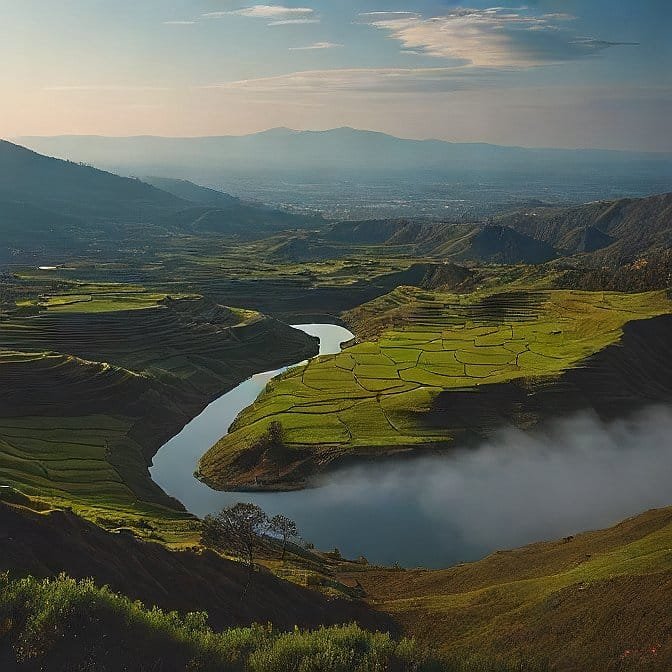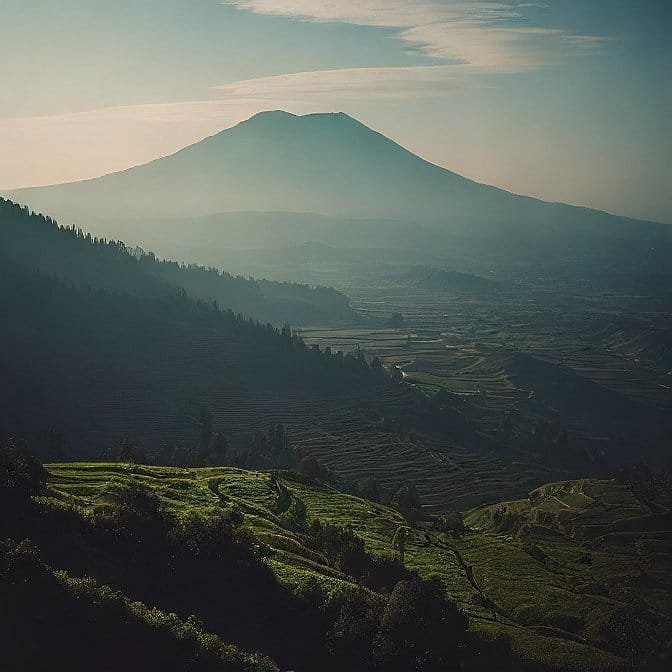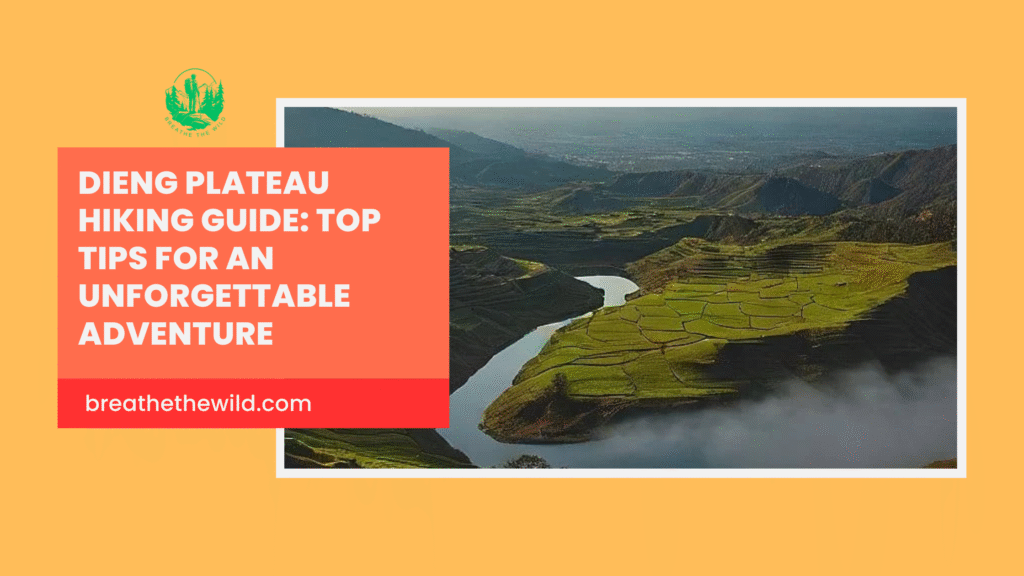Table of Contents
Introduction: Step into the Mystical World of Dieng Plateau

Deep in the mountains, Dieng Plateau is the hidden jewel for tourists who enjoy hiking and the nature side of Central Java. This Mountain Volcano is situated at an altitude that is above the mountainous land that is more than 2,000 meters, and this is a topography where one would travel and mix up steaming craters with misty hills, ancient temples that are ancient and the magical flame sun rise, which would make one think that such an adventure was unbelievable.
Unlike the rest of the tourist attractions in Indonesia, where they have been largely overcrowded, the hiking experience at the plateau of Diengg will offer an ideal experience with nature right into the heart of the atmosphere and with a touch of spirituality. Whether you’re venturing up Mt Prau for wide sun-laced horizons or wandering the enigmatic Telaga Warna (Color Lake) through green moonscaped venduras, taking a step anywhere in Dieng is an otherworldly experience.
However, this hike is not only about beauty. The plateau is rich in culture, history, and the local legends that contribute to a mystical spice in your travel. You will go past Hindu temples that date back to the dark ages, see volcanic action with your own eyes, and even have a chance to meet the the once-a-year Dieng Culture Festival, where the locals rejoice with their cultural history.
Where Is the Dieng Plateau? How to Get There with Ease
Dieng Plateau is situated in Indonesia, the central part of Java, in Wonosobo. It is considered an area in the highlands that is supposedly cool in climatic conditions, of a volcanic landscape, and it has a mystic feeling in it, and it was found to be elevated to an altitude of 2000 meters above sea level. It is geographically situated exactly at the center between Yogyakarta city and Semarang or Jakarta city to the point that it is accessible even through the largest travel destinations.
You can visit Magelang and Wonosobo along the beautiful routes, which are estimated to take four to five hours of driving time if you are traveling by car out of Yogyakarta. Semarang to here takes about three or four hours by way of Temanggung. It takes more time to get here than one from Jakarta, approximately ten to twelve hours, and most of the time through the toll road, through Purwokerto, and continued to Wonosobo. The most convenient and flexible method of travel is a private car or an impressionable tour bus.
Among people who utilize public transport, trains to Purwokerto or Kutoarjo give access to Wonosobo. There, you can get minibuses and shared vans going up to the Dieng area. Main roads also host direct buses that lead to Yogyakarta and Semarang to the main terminal in Wonosobo. The most visited base of the hikers is Dieng Village with its multiple guesthouses and local guides. Other entry points to the plateau and its hiking trails are the neighbouring towns, including Kejajar and Batur.
Top Hiking Trails in the Dieng Plateau You Can’t Miss
Hiking in Dieng Plateau is an adventurous and attractive journey to nature that is captivating to both a new person and an experienced one. It is in a mystical area of volcanoes, beautiful, colored lakes, and unforgettable sunrise points.
Mount Prau is one of the best-known hikes in Dieng. It is a medium difficulty trail that will require approximately two to four hours to reach the top, once above which hikers will be treated to beautiful views over Mount Sindoro and Mount Sumbing and even Mount Merapi, on a clear morning. Amongst the mountains or volcanoes, Mount Prau is particularly well-known because of its sunrise, which has been referred to as one of the greatest in Central Java.
The other hike, which you cannot miss, concerns Sikunir Hill. It is considerably less and less difficult a trip, which takes about 30-45 minutes, yet the reward is the wonderful impression of the Golden Sunrise that lights the sky up with the reddish tones. Sikunir would be the most ideal for more adventurous trails or people with less time and who intend to see a remarkable sunrise.
In another type of trail, one must go around Telaga Warna, or the Color Lake, picturesquely referred to as a walking experience. These hikes travel through exuberant vegetation and offer hikers a glimpse of the trends in the colors of the lake owing to the volcanic mineral content in the region. It is a calm, near-unreal location to walk around.
Both hikes are unique in their offerings and almost distinct- dramatic mountains to serene, lake strolls to golden skies in the mornings. The Dieng Plateau is indeed something that accommodates any type of adventure seeker.
Best Time to Visit the Dieng Plateau for Ideal Hiking Conditions

All the aspects can fall into place when planning your visit to the Dieng plateau, particularly at instances when you want to make perfect sunrise shots and have safe and hitch-free hiking. There is a dry season from June to August, which is the most favorable time to visit. The weather is cooler, and skies clearer, not to mention that the trails are, in general, safer and less slippery, these months. This is also the time you would have the best chance to witness the most beautiful sight of the Dieng sunrise in full grandeur without any cloud or rain to spoil the view.
The rainy season is generally perceived between October to April because of the unexpected weather and muddy paths. This is the time when one might as well be allowed to do some hiking; however, visibility is not so great, and some of the routes might not be so easy to navigate. As soon as it is morning, particularly about hiking in rainy seasons, since it would clear up during the morning.
Planning to do it during the weekdays as opposed to weekends may enable you to prevent the crowds and get a friendlier hiking experience. Sunrise hikes are especially in vogue, and due to this, most people begin their hikes at 3-4 in the morning so that they have the best chance to see the sunrise in an isolated location.
Check Out: Mount Batur Sunrise Hike: 3 Epic Adventures You’ll Never Forget.
What to Pack for Hiking in Dieng Plateau’s Highlands
Going out to hike to Dieng plateau, there are things you should take and leave that either help your trip or make it a disaster. The elevation, together with the mountain weather, also means that early days are cold and windy even in the dry season. Warm wear: You definitely need thermal, a beanie, and gloves too, particularly when you are out on a sunrise hike. This rain/ windbreaker would also be essential, and on some days, we could have a sudden change of weather that could produce some fog or even raindrops on a seemingly sunny day.
With rough grassy slopes and winding ways of Dieng, shoes are a lot. A pair of good hiking shoes that are not slippery in muddy routes will suffice to stay safe in areas around volcanic areas easily or in wetlands by lakes. Most of the hikes start early in the morning, and it is necessary to bring a good headlamp or flashlight. Neither should you forget to bring high-energy snacks, bottled water, and maybe a thermos of a nice warm drink; a little comfort can go a long way up in the air.
Dieng plateau stands at around 2000 meters above sea level, and this could cause some cases of altitude discomfort to hikers. DO it as you have time, and drink lots of fluid and rest when ascending steeply. When you are well-equipped with gear and preparation, you will enjoy and remember your hike.
What to Expect: Terrain, Altitude, and Scenic Surprises

The highlands of Dieng are an interesting mix of trails and elevation and are well suited to the adventure traveller in search of ever-changing terrain and altitudes. Most of the paths go through the grassy ridges, volcanic environment, and fog valleys. A few of the hikes are considered easy and novice folks can hike, but a few are extremely steep and difficult, let even to the likes of the climb up to Mount Prau is beyond dangerous during a rainy, wet day, or morning dew.
In other words, it will test your stamina levels, even in shorter hikes. Reward, what of reward? The scenery all around is beautiful. Churning lava craters to jewel-like emerald-green lakes like Telaga Warna, views of Mount Sindoro and Sumbing to the dazzling backdrop, the Dieng Plateau is one surprise after another.
The wonder of nature also sounds in the trails. When you get nearer active geothermal fields, you may see a few of the alpine plants, Alpine meadows of Edelweiss, and smell the odor of sulfur. Such landscapes are dynamic to such an extent that every step on your hike can turn into a memory you are going to tell about.
Conclusion: Embrace the Magic of the Dieng Plateau
It is not just the highland hiking region but, in fact, a mix of raw nature and old culture in an ideal setting that the Dieng plateau is. Breathtaking mountaineering tours by the sunlight through the thick mist on top of Mount Prau, thick soothing lakes like Telaga Warna, sacred temple ruins that permeate the entire landscape, every step up the trail is like you are walking out of a book of a living fairytale.
Be it an advanced trekker, a random tourist, or a person interested in cultures, the Dieng Plateau shall have something relatively memorable to present to you. Its airy sceneries, breathtaking sceneries, and spiritual atmosphere create a perfect hiking adventure that one can never erase after the hike is completed.
Assuming you are planning your travel, packing, and being at the right place, then your journey in the Dieng plateau can be great and wonderful. Hike quietly in the tracks, immerse yourself a little with local culture, and you are all set to fall in love with one of the most enchanting regions of central Java.
For More Info: Click Here!
Frequently Asked Questions (FAQs)
1. How difficult/ hellish is the hiking in Dieng Plateau?
Most of the hiking terrains at the Dieng Plateau are medium. The other well-known hikes, like Sikunir Hill, are easy to make it through without being a professional, and also Mount Praw, which may be difficult because the hiking trail on this mountain is too steep. However, even such a physical state and preparation will allow following every hike.
2. Or do I even have to visit Dieng with a guide?
Of course, not every trail ends up badly marked and unsafe, so far as I am aware, with famous Sikunir and Telaga Warna. However, when taking a long or off-route journey like in Mount Prau, it is advisable to hire local guides so that one can be in a position to assist with local knowledge and safety.
3. What is the time that I must get to Dieng Plateau to watch the sunrise?
The best time to enjoy the panorama is the dry season and which is between June to August. You will want to start your trek between 3 AM to 4 AM, and even that is too late to reach the most popular sunrise sights, Sikunir Hill or Mount Prau. During weekdays, there are not so many people taking hikes.



